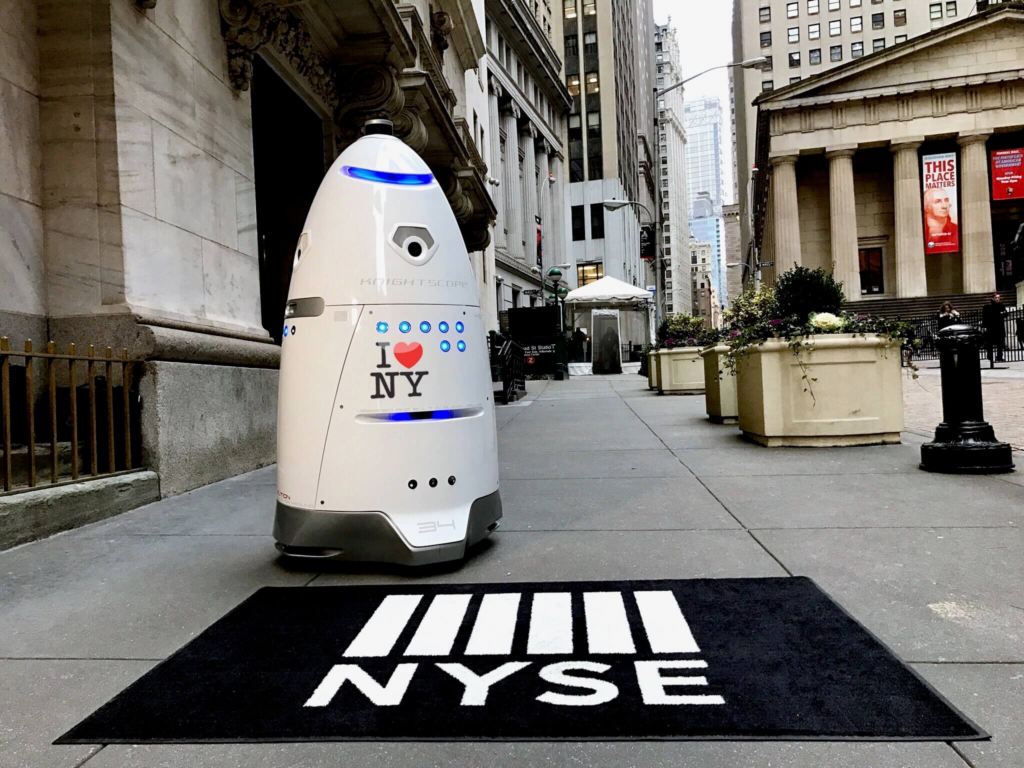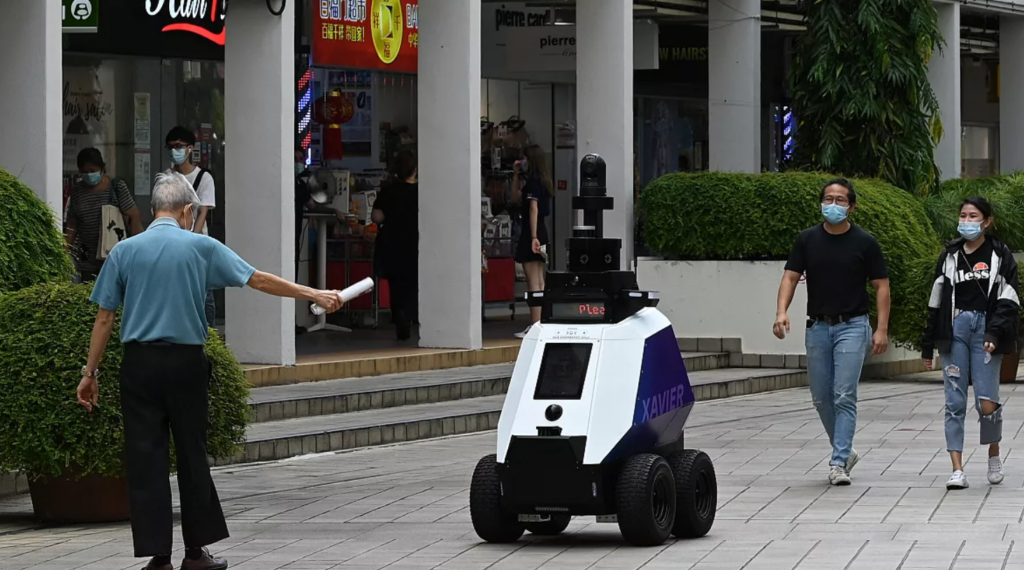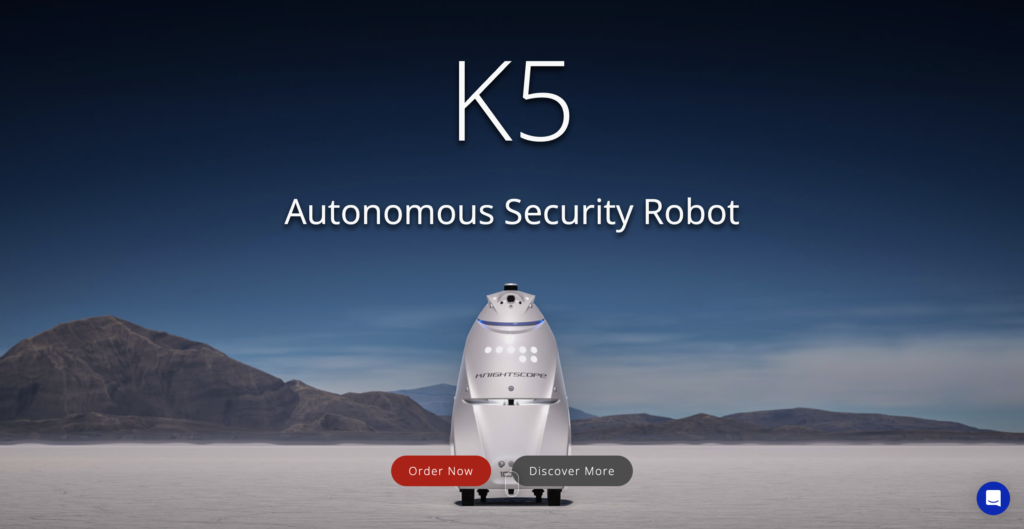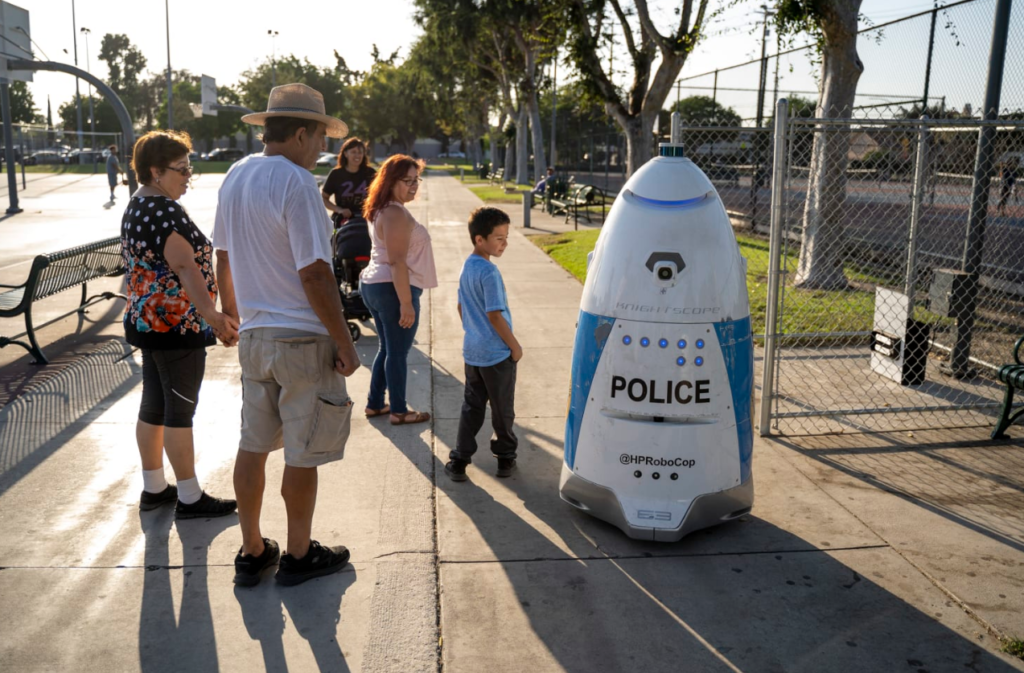Table of Contents
You’re walking down a bustling city street or a park, and instead of a police officer patrolling the area, you see a sleek robot—its sensors constantly scanning, analysing faces, and monitoring every movement around you. This isn’t science fiction. It’s happening now. In cities like New York, Dubai, and Singapore, robots are helping maintain public safety. As these machines become a part of daily life, one pressing question remains: are they making us safer, or are they quietly eroding our privacy?
Rise of Police Robots
Robotic policing is fast becoming a global phenomenon. Take the Knightscope K5, for example, patrolling subway stations in New York, or Dubai’s very own “Robocop,” helping tourists and keeping the streets clear of trouble. Across the world, law enforcement is relying on robots to augment human officers. And these aren’t just clunky machines rolling down the street—they come packed with tech straight out of a sci-fi movie. Think 360-degree cameras, facial recognition, registration plate scanners, smoke detectors, and even sensors that can pick up on mobile phone signals.


Knightscope K5 robots were trialled to help with public safety in areas like Times Square. Meanwhile, Dubai has deployed its humanoid Robocop since 2017, using it to issue fines and monitor behaviour. Singapore, always a step ahead in tech adoption, introduced patrol robots like “Xavier” to enforce social distancing rules during the pandemic and deter what it deems ‘undesirable behaviour.’

But as these robots roll through our streets, a deeper issue comes into play. While they promise to make public spaces safer, how much of our privacy are we trading away in the process? A lot, more than we’re signing up for.
Why HP RoboCop Was Created
HP RoboCop was developed by Knightscope to support traditional policing. The idea was simple—local police are under pressure to provide round-the-clock protection, but budgets and resources are tight. So why not introduce a machine to keep watch? It’s the perfect solution: 24/7 passive surveillance and data collection without human fatigue. Plus, its mere presence could act as a deterrent to crime. HP RoboCop was one of the first real-world attempts to test these capabilities, beginning in Huntington Park.

The goal was to reduce police workloads, cover more ground, and make law enforcement more efficient. But, despite its high-tech appeal, the introduction of robotic policing has been met with scepticism. It raises important questions about what we’re giving up in the name of safety.
Real-World Trials: Mixed Outcomes
Take Huntington Park in California, where the HP RoboCop was trialled. The feedback? A mixed bag. It was designed to lighten the load of officers and provide around-the-clock surveillance, but the reality wasn’t so straightforward. Many residents felt uneasy about its constant data collection, and its real-world effectiveness was questioned. After the trial, authorities had to rework its software and patrol areas to address concerns.
Interestingly, robots like HP RoboCop often see their trials cut short. In New York, after deploying Knightscope K5 in the subway system in 2023, the trial was quietly discontinued after just two months. No official reason was given. This suggests one thing: while robots can gather data and patrol public spaces, using them in densely populated areas throws up challenges we haven’t fully tackled. And the data collected during these trials even, we don’t really know.
There are some success stories though. In Dubai, the public seems to have embraced their Robocop, perhaps reflecting the city’s wider acceptance of futuristic tech. Similarly, Singapore’s Xavier patrol robots have largely been welcomed, illustrating how cultural factors might play a role in public acceptance.
But regardless of how cool these robots might seem on the surface, we’re left wondering: who controls the data they collect, and how much do we really know about it?
Invasion of Privacy and Civil Rights
Here’s where things get complicated. To say that crime prevention through videotape vigilance is an antidote to crime per se, on the other hand, stokes red flags from a very grave concern: privacy.
These robots, like HP RoboCop, are equipped with cameras that are constantly recording. Proponents argue that this level of surveillance can prevent crime and make public spaces safer. But at what cost?
Imagine being under continuous watch as you go about your day, with no clarity on how the data collected is used. Privacy advocates, like the American Civil Liberties Union (ACLU), have been vocal about their concerns. They argue that this is just the beginning of a slippery slope towards mass surveillance. There’s already unease about companies like Knightscope having unprecedented access to personal information. And with no clear regulations on how this data is stored, shared, or who controls it, the potential for misuse is significant.

We’ve seen what can happen when data is mishandled—take the Cambridge Analytica scandal as a prime example. Now, imagine that on a public scale, where every interaction, every movement, is recorded and analysed. Who’s to say this data won’t be used to profile individuals or specific communities?
At this level of intensity, surveillance alone could quickly foster a “Big Brother” mentality, with citizens being spied on and overwatched without so much as a nod in that direction from their government.
Balancing Safety with Civil Liberties
Sure, robots can reduce risks for human officers, especially in dangerous situations. Think of the 2016 Dallas police standoff where a robot delivered explosives to neutralise a gunman, preventing further casualties. Or in 2013, when robots helped defuse bombs after the Boston Marathon attack.
But what about the grey areas? Unlike human officers, robots lack the ability to exercise discretion. They follow pre-programmed instructions, and that’s a problem when it comes to crowd control or protests, where human judgement is often necessary. Critics argue that robotic policing needs strict regulations to prevent excessive force or misuse. Robots can’t ‘read the room’ like humans can, which could escalate situations unnecessarily.
Hidden Biases in AI Systems
One of the most concerning aspects of robotic policing is the hidden bias in the AI that powers these machines. Research from MIT Media Lab has shown that facial recognition software is far less accurate at identifying people of colour compared to white individuals. This raises a serious risk of unjust targeting and wrongful arrests, further compounding existing inequalities in law enforcement.

We might think of robots as neutral, but AI systems often reflect the biases of the data they’re trained on. If most training data includes lighter-skinned individuals, it’s no wonder the system struggles with diverse populations. This is not just a technical glitch; it has real-world consequences. People from marginalised communities could find themselves disproportionately surveilled and unfairly targeted—further deepening the inequalities that already exist in law enforcement.
Public Safety vs. Privacy
Picture this: you’re in a park and something goes wrong. You see a police robot and press its alert button, expecting help to arrive. But instead, the robot ignores you and continues on its patrol. When a woman in Huntington Park tried to get help from a robot during a fight in a park, it simply told her to step aside and continued its pre-programmed patrol. Finally, somebody had to call the emergency hotline and fifteen minutes later, this woman who was part of the fight was rolled out on stretcher with a bleeding cut on her head.

This raises the question: can we really rely on robotic policing? For every benefit these machines offer, there are concerns that the line between public safety and privacy is becoming dangerously blurred. Constant surveillance could create an environment where citizens are afraid to express themselves, to protest, or even to go about their daily lives without feeling like they’re being watched. With features like facial recognition and behavioural analysis likely to be included in future models, these concerns are only going to grow.
Advocates believe that the low prices this type of robotics offers for the expansion of police patrols make detractors argue that constant surveillance will result in a suffocating environment if there are few regulations placed on how the data may be used or shared.
Future of Robotic Policing
Like it or not, robotic policing is here to stay. These machines will only get more advanced, with AI systems becoming more capable of recognising threats and potentially acting without human intervention. This raises some tough questions for society. How much privacy are we willing to give up in exchange for safety? What safeguards need to be in place to protect civil liberties?

The trials in Huntington Park and New York show the limitations of these systems, but success stories in places like Dubai and Singapore suggest that robotic policing can work if implemented correctly. As this technology continues to evolve, we need to ensure that it serves us, rather than controls us.
We’d love to hear your thoughts on robotic policing. How do you feel about the balance between safety and privacy? Let us know by sharing your comments or personal experiences at @editor.mindbrews.in.